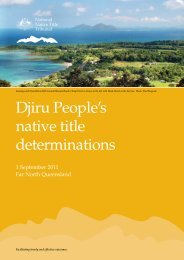Biodiveristy_State of Environment report - Mission Beach Cassowaries
Biodiveristy_State of Environment report - Mission Beach Cassowaries
Biodiveristy_State of Environment report - Mission Beach Cassowaries
- No tags were found...
You also want an ePaper? Increase the reach of your titles
YUMPU automatically turns print PDFs into web optimized ePapers that Google loves.
2.1.2 Roads andInfrastructurePressureRoads and infrastructure such as powerlinesimpact upon floral biodiversity by creatinggaps in the connectivity <strong>of</strong> forests and otherecosystems. This creates an edge to theecosystem, which alters themicroenvironment. Consequently, differentspecies are promoted, which alters the ecosystem'scomposition. A greater problem is the incursion <strong>of</strong> weedsand pest animals along the cleared avenue. Further, in somecases endangered species such as cassowaries may beattracted to road verges because <strong>of</strong> fruiting weeds, placingthe species at greater risk <strong>of</strong> being struck by a car.Roads can form a significant barrier to the movement <strong>of</strong>fauna, either because they will avoid the road, or becausecars on the road cause mortality, affecting the species’population. Animals may need to cross the road to feed,establish new territories, to breed, or to migrate as part <strong>of</strong>their lifecycle. Otherwise they may simply encounter roadareas randomly during daily movements.Infrastructure associated with roads can also form a physicalbarrier to some species, particularly where roads bisectstreams. This is the case when stream drainage is divertedthrough pipes emptying above the downstream water level.This can prevent aquatic species from occupying their fullrange.Power line corridors are usually grassed areas where theypass through areas <strong>of</strong> forest, so that the lines can be accessedfor maintenance. The difference in habitat can affect somespecies, either because they avoid it, or because the openarea makes them more vulnerable to predators.ConditionDetailed information is not collected for the impact <strong>of</strong> roadson any species except for <strong>Cassowaries</strong>. C4 and QPWSrecord cassowary road deaths and map these incidents toidentify trouble spots.Some information is available for other species• Through Council clean up <strong>of</strong> large roadkills – mainlykangaroos and wallabies, but also feral pigs - based on<strong>report</strong>ed dead animals by the public.• Through wildlife care groups who nurse injured animals -when they are <strong>report</strong>ed or brought in.This information will only be a small subjective sample <strong>of</strong>actual number <strong>of</strong> incidents.WTMAThe only changes that have occurred to maintained roads andtheir classification under the Wet Tropics Management Planhave been to forestry roads in the Palmerston WHA in 2003."These changes were associated with the Misty MountainsTrails project which provides a network <strong>of</strong> short and longdistance walks. Two sections <strong>of</strong> road were reclassified underthe plan to facilitate access to the walking track networkincluding the reopening <strong>of</strong> 4km <strong>of</strong> disused forestry road andthe reclassifying <strong>of</strong> 4km <strong>of</strong> management road to presentationrestricted road" (WTMA, 2004).Red legged Pademelons at WildcareSource: WildcareThe impact associated with these changes will be minimal,and will encourage better appreciation and utilisation <strong>of</strong> theWHA.PowerlinkPowerlink are replacing the deteriorating power linetravelling through the WHA, with a line along the coastthrough mainly agricultural land. An <strong>Environment</strong> ImpactAssessment (EIA) was conducted, with a balance soughtbetween environmental issues and serious communityconcerns, as well as the difficulty <strong>of</strong> maintaining a powerline service in the topography <strong>of</strong> the WHA. The EIA wasreferred to the Federal Department <strong>of</strong> <strong>Environment</strong> andHeritage, who have given Powerlink permission toconstruct the power line along the coastal route."Powerlink expects to acquire easements between Tullyand Innisfail by April 2006, with construction expected tocommence in May 2006 (subject to suitable weather).Construction should be completed by the second half <strong>of</strong>2007" (Powerlink Website, 2005).Revegetation in the WHA will accompany dismantling <strong>of</strong>the old infrastructure. These revegetation plans are yet to bedeveloped through community consultation andinvolvement from WHA stakeholders.Rec: Powerlink develop a strategic approach to ensurecomplete revegetation over time and restoration <strong>of</strong> WHAnatural values, upon removal <strong>of</strong> power line infrastructure inthe WHA.ResponseWhere it is noted that a road is affecting significantnumbers <strong>of</strong> a species or a number <strong>of</strong> species, managementis required to help prevent the problem. This for examplecould include changing speed limits, or weed control <strong>of</strong>road verges.<strong>Mission</strong> <strong>Beach</strong> Wildcare and Wildlife CarersThese organisations tend injured wildlife, and raiseorphaned animals. The majority <strong>of</strong> their work withmammals is due to collisions with cars, though dog attacksare also a factor.QPWSQPWS currently manage temporary signage, which isplaced where cassowaries are <strong>report</strong>ed to regularly cross aroad. This is more effective than permanent signage, asdrivers gradually come to ignore such signage when theydo not <strong>of</strong>ten see a cassowary.37



